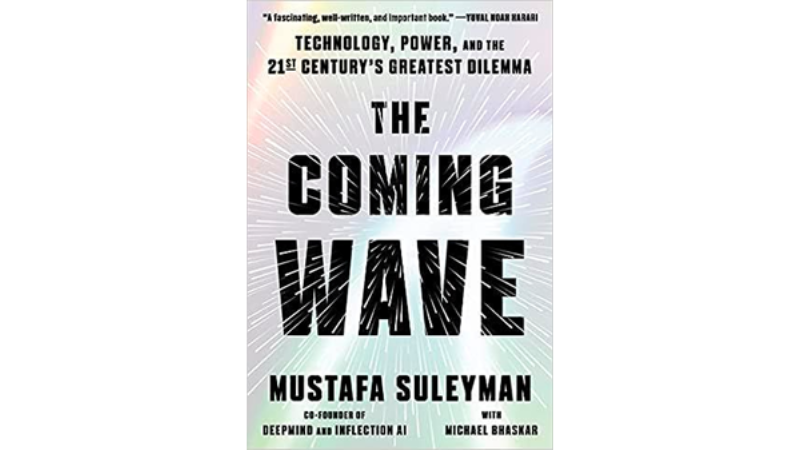
Book Note #2
Equity Intelligence 6th October 2023
Mustafa Suleyman is one the most important voices in the area of artificial intelligence. He is the co-founder and CEO of Inflection AI. Previously he co-founded DeepMind, one of the world's leading artificial intelligence companies. After a decade at DeepMind, Suleyman became vice president of AI product management and AI policy at Google. He has co-authored with Michael Bhaskar an extremely important and relevant book for times we are about to enter on the back of the AI revolution.
The DeepMind co-founder calls for the ‘containment’ of new technology in a heartfelt and candid exploration of what the future may hold for us. He not only tells the story of the coming technological revolution but also suggests steps to ensure that it ends well for all of us. While some would say it is indirectly arguing for more regulations; we feel he is honest in his intent to see a net positive impact for all.
Here are a few passages from the book:
- Almost every foundational technology ever invented, from pickaxes to ploughs, pottery to photography, phones to planes, and everything in between, follows a single, seemingly immutable law: it gets cheaper and easier to use, and ultimately it proliferates, far and wide.
- Invention is an unfolding, sprawling, emergent process driven by self-organizing and highly competitive inventors, academics, entrepreneurs, and leaders, each surging forward with their own motivations. This ecosystem of invention defaults to expansion. It is the inherent nature of technology.
- Every principle and abstract concept, every small creative endeavor or project, every encounter in your life, has been mediated by our species’ unique and endlessly complex capacity for imagination, creativity, and reason. Human ingenuity is an astonishing thing. Only one other force is so omnipresent in this picture: biological life itself.
- The coming wave is defined by two core technologies: artificial intelligence (AI) and synthetic biology.
- AI has been climbing the ladder of cognitive abilities for decades, and it now looks set to reach human-level performance across a very wide range of tasks within the next three years.
- Beyond AI, a wider revolution was underway, with AI feeding a powerful, emerging generation of genetic technologies and robotics. Further progress in one area accelerates the others in a chaotic and cross-catalyzing process beyond anyone’s direct control.
- Once matured, these emerging technologies will spread rapidly, becoming cheaper, more accessible, and widely diffused throughout society. They will offer extraordinary new medical advances and clean energy breakthroughs, creating not just new businesses but new industries and quality of life improvements in almost every imaginable area.
- And yet alongside these benefits, AI, synthetic biology, and other advanced forms of technology produce tail risks on a deeply concerning scale. They could present an existential threat to nation-states—risks so profound they might disrupt or even overturn the current geopolitical order. They open pathways to immense AI-empowered cyberattacks, automated wars that could devastate countries, engineered pandemics, and a world subject to unexplainable and yet seemingly omnipotent forces. The likelihood of each may be small, but the possible consequences are huge.
- Waves are everywhere in human life. This one is just the latest. Often people seem to think it’s still far off, so futuristic and absurd-sounding that it’s just the province of a few nerds and fringe thinkers, more hyperbole, more technobabble, more boosterism.
- Technology has a clear inevitable trajectory: mass diffusion in great roiling waves. This is true from the earliest flint and bone tools to the latest AI models. As science produces new discoveries, people apply these insights to make cheaper food, better goods, and more efficient transport. Over time, demand for the best new products and services grows, driving competition to produce cheaper versions bursting with yet more features. This in turn drives yet more demand for the technologies that create them, and they also become easier and cheaper to use.
- The human story can be told through these waves: our evolution from being vulnerable primates eking out an existence on the savanna to becoming, for better or worse, the planet’s dominant force. Humans are an innately technological species. From the very beginning, we are never separate…
- Throughout history, population size and innovation levels are linked. New tools and techniques give rise to larger populations. Bigger and more connected populations are more potent crucibles for tinkering, experimentation, and serendipitous…
- Waves—pulsating, emergent, successive, compounding, and cross-pollinating—define an era’s horizon of technological possibility. They are part of us. There is no such thing as a non-technological human being. This conception of history as a series of waves of innovation is not novel. Sequential and disruptive clusters of technologies recur in discussions of technology. For the futurist Alvin Toffler, the information technology revolution was a “third wave” in human society following the Agricultural and Industrial revolutions. Joseph Schumpeter saw waves as explosions of innovation igniting new businesses in bursts of “creative destruction.” The great philosopher of technology Lewis Mumford believed the “machine age” was actually more like a thousand-year unfolding of three major successive waves. More recently, the economist Carlota Perez has talked about “techno-economic paradigms” rapidly shifting amid technological revolutions. Moments of booming disruption and wild speculation regear economies. Suddenly everything relies on railways, cars, or microprocessors. Eventually, the technology matures, becoming embedded and widely available.…
- When Gutenberg invented the printing press around 1440, there was only a single example in Europe: his original in Mainz, Germany. But just fifty years later, a thousand presses were spread across the Continent. Books themselves, one of the most influential technologies in history, multiplied with explosive speed. In the Middle Ages manuscript production was on the order of hundreds of thousands per major country per century. One hundred years after Gutenberg, countries like Italy, France, and Germany produced around 40 million books per half century, and the pace of acceleration was still increasing. In the seventeenth century, Europe printed 500 million books. As demand soared, costs plummeted.
- Since the early 1970s, the number of transistors per chip has increased ten million-fold. Their power has increased by ten orders of magnitude—a seventeen-billion-fold improvement. Fairchild Semiconductor sold one hundred transistors for $150 each in 1958. Transistors are now produced in the tens of trillions per second, at billionths of a dollar per transistor: the fastest, most extensive proliferation in history.
- History tells us that technology diffuses, inevitably, eventually to almost everywhere, from the first campfires to the fires of the Saturn V rocket, from the first scrawled letters to the endless text of the internet. Incentives are overwhelming. Capabilities accumulate; efficiencies increase. Waves get faster and more consequential. Access to technology grows as it gets cheaper. Technology proliferates, and with every successive wave that proliferation accelerates and penetrates deeper, even as the technology gets more powerful. This is technology’s historical norm.
- Alan Turing and Gordon Moore could never have predicted, let alone altered the rise of, social media, memes, Wikipedia, or cyberattacks. Decades after their invention, the architects of the atomic bomb could no more stop a nuclear war than Henry Ford could stop a car accident. Technology’s unavoidable challenge is that its makers quickly lose control over the path their inventions take once introduced to the world.
- Technology exists in a complex, dynamic system (the real world), where second-, third-, and nth-order consequences ripple out unpredictably. What on paper looks flawless can behave differently out in the wild, especially when copied and further adapted downstream. What people actually do with your invention, however well-intentioned, can never be guaranteed.
- Gutenberg just wanted to make money printing Bibles. Yet his press catalyzed the Scientific Revolution and the Reformation, and so became the greatest threat to the Catholic Church since its establishment. Fridge makers didn’t aim to create a hole in the ozone layer with chlorofluorocarbons (CFCs), just as the creators of the internal combustion and jet engines had no thought of melting the ice caps.
- Understanding technology is, in part, about trying to understand its unintended consequences, to predict not just positive spillovers but “revenge effects.”
- Technology’s problem here is a containment problem.
- The more powerful a technology, the more ingrained it is in every facet of life and society. Thus, technology’s problems have a tendency to escalate in parallel with its capabilities, and so the need for containment grows more acute over time.
- Containment encompasses regulation, better technical safety, new governance and ownership models, and new modes of accountability and transparency, all as necessary (but not sufficient) precursors to safer technology. It’s an overarching lock uniting cutting-edge engineering, ethical values, and government regulation.
- People throughout history have attempted to resist new technologies because they felt threatened and worried that their livelihoods and way of life would be destroyed.
- Once established, waves are almost impossible to stop.
- Technology’s nature is to spread, no matter the barriers.
- Technology is an eternally dangling carrot, constantly promising more, better, easier, and cheaper. Our appetite for invention is insatiable. The seeming inevitability of waves comes not from the absence of resistance but from the demand overwhelming it. People have often said no to desired contained technology for a plethora of reasons. It’s just never been enough. It’s not that the containment problem hasn’t been recognized in history; it’s just that it has never been solved.
The upcoming tech wave, focused on AI and synthetic biology, promises vast wealth, medical breakthroughs, clean energy, and better quality of life. However, it could also empower harmful actors, causing disruptions or worse. Suleiman proposes a ten-step plan to ensure the safe and responsible use of these technologies from technical safety measures to fostering a culture of tech responsibility. We recommend the book.


